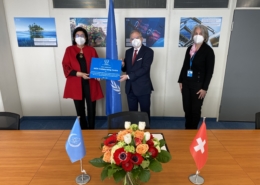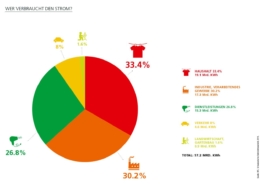Too valuable to throw away: discarded components can be used for conversions and new buildings. Component exchanges and networks ensure that "circular construction" also works in Switzerland.
What an online marketplace! The offer includes, for example, a "hot-dip galvanized steel external staircase with railing" for 2500 francs. It comes with a technical drawing and a short story: the staircase has never been used, and it had to be dismantled immediately due to an appeal. On useagain.chthe platform for component reuse, you can also find "Moroccan cement tiles, originally packed on pallets", garage doors, various windows, insulation panels, sinks etc. "Many look at the items first online and then in person with us," says Manuel Herzog, head of Bauteilbörse Basel, between rows of toilet bowls, shower trays and parquet samples on display.
Driving component reuse forward
Founded more than 20 years ago, the institution is one of the professional providers that advertise on the Swiss online platform and work together to ensure that the idea of component reuse becomes more and more widespread in Switzerland. And this is necessary in order to conserve valuable resources and reduce energy consumption and the carbon footprint in the construction sector, emphasizes Andreas Sonderegger, Co-Head of the Institute of Structural Design at the ZHAW Zurich University of Applied Sciences.
It's time for a fundamental rethink, he says. "We must no longer regard disused buildings as waste; they are raw materials," says Sonderegger, co-editor of the book "Bauteile wiederverwenden - ein Kompendium zum zirkulären Bauen." It was written in connection with the award-winning showcase example of component reuse in Switzerland: Kopfbau 118 on the Sulzer site in Winterthur is the largest building constructed predominantly from reused components. Compared to a conventional new building, 60 percent of greenhouse gases were thus avoided.
Reuse was common in the past
Reuse building components one-to-one as far as possible, i.e. without spending energy on recycling processes: What is now a trendy topic in the architectural scene as "component reuse" was common practice in the past. Andreas Sonderegger: "In Switzerland, with its half-timbered and knitted buildings, the reuse of wood in particular had a long tradition. And if a wall was no longer needed, you could knock the mortar off the stones and reuse it." But today, he says, wood is often glued, mortar is harder than the stones, and labor is more expensive than material. The reawakening of reuse stands or falls with that last point.
Genuine craftsmanship
The fact that people used to save on materials rather than labor is shown by the small treasures on offer at Bauteilbörse Basel: hand-forged metal railings, ornately carpentered wooden doors. "Such elaborate craftsmanship is hardly affordable today," explains Manuel Herzog.
The cost factor of labor is also decisive in the question of which components the exchange even includes in its offer. That's because the team gets most of the parts itself from demolition objects and prepares them. That's work, that's cost. But a distinction has to be made here, Herzog explains. "One part, the preparation of the components, is an opportunity for integration companies like us." The Bauteilbörse Basel is run by the Overall cooperative, which is committed to integrating young people and adults into the world of work. "But the other part, disassembling usable components at the construction site, that can be done quite economically," Herzog says.
Don't throw away usable parts
When a house or part of a house needs to be deconstructed, the owner can contact the component exchange. "Most of the time, these are people who care about making sure usable things don't just get thrown away. For others, the focus is on saving money," says Manuel Herzog. When a request is made, he looks at the house and decides which components are suitable for the exchange. These are then removed by permanent craftsmen and program participants of the component exchange. In order to increase the chances of sale, a good network is needed, says Manuel Herzog.
Room for maneuver helps in the search for components
140 windows are stored in a basement of Overall Baubetriebe. All from a deconstructed apartment building, used but in top condition and with the insulation values required today. Throwing them away would be a bad idea. But removing them from the demolition site and then storing them is not a mature idea either. After all, both involve costs that have to be covered. That's why these 140 windows aren't just waiting for a door to open for them someday, somewhere. No, they are reserved for a re-use construction project - thanks to the network and "component matching".
"Bauteil-Matching" is the matching of supply and demand and works via an online platform. Here, for example, Manuel Herzog indicates that windows could be removed from a demolition object. On the other side of the matching are interested parties such as Jasmin Amann from Zirkular GmbH. She is an architect, reuse expert and "component hunter," as her business card says. She, too, takes windows as an example: for a new building, she was looking for 60 pieces and created a corresponding search profile. "Because we don't get very far with rigid sizes, approximate specifications are recorded," she says. "The more flexible the parameters, the higher the chance of a hit." So here it worked. She was able to look at the windows before they were removed, after which they were disassembled along with the shutters. And after the shortest possible storage, they start a second career in a new building. Manuel Herzog from Bauteilbörse Basel sums it up: "Reuse means: no additional CO2 emissions for production, but new jobs."
Creative solutions for remodeling
A project by the in situ construction office in Roschach (SG) shows how building components can be reused right on the spot. Join architect Meret Hodel on a tour of the "TraumRecyclingHaus" and learn how component reuse stimulates the creativity of everyone involved.


 IAEALabor Spiez festigt die Zusammenarbeit mit der Internationalen Atomenergie-Organisation (IAEA)
IAEALabor Spiez festigt die Zusammenarbeit mit der Internationalen Atomenergie-Organisation (IAEA)  BFEFakten und Zahlen: Wer verbraucht den Strom?
BFEFakten und Zahlen: Wer verbraucht den Strom?  «Kommt da was aufs Dach?»
«Kommt da was aufs Dach?»  shutterstockManipulation oder Hilfestellung? Wie Nudging unser Verhalten beeinflusst.
shutterstockManipulation oder Hilfestellung? Wie Nudging unser Verhalten beeinflusst. 
 Shutterstock
Shutterstock VenTSol
VenTSol
Neuste Kommentare